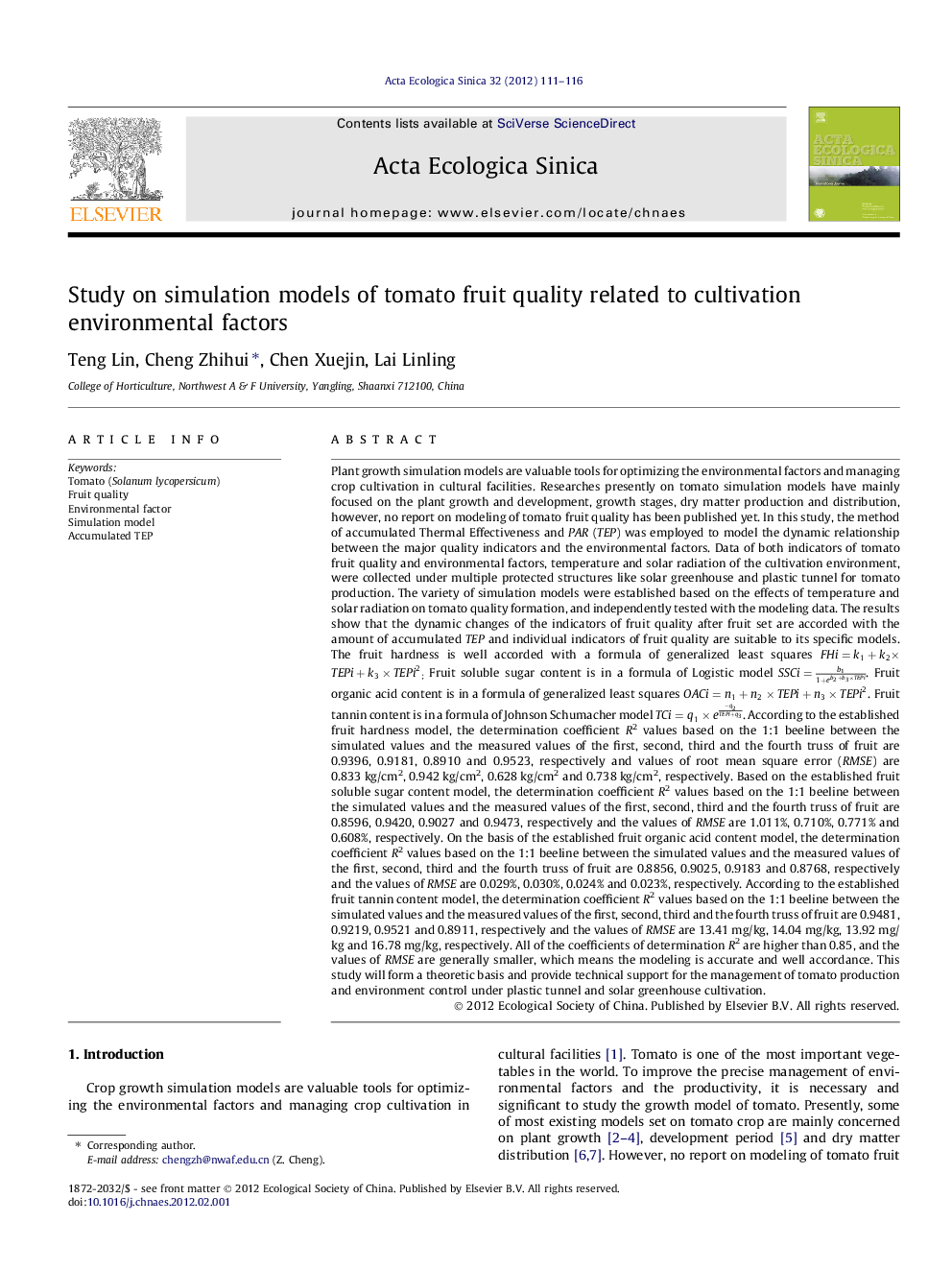| کد مقاله | کد نشریه | سال انتشار | مقاله انگلیسی | نسخه تمام متن |
|---|---|---|---|---|
| 4380002 | 1303957 | 2012 | 6 صفحه PDF | دانلود رایگان |

Plant growth simulation models are valuable tools for optimizing the environmental factors and managing crop cultivation in cultural facilities. Researches presently on tomato simulation models have mainly focused on the plant growth and development, growth stages, dry matter production and distribution, however, no report on modeling of tomato fruit quality has been published yet. In this study, the method of accumulated Thermal Effectiveness and PAR (TEP) was employed to model the dynamic relationship between the major quality indicators and the environmental factors. Data of both indicators of tomato fruit quality and environmental factors, temperature and solar radiation of the cultivation environment, were collected under multiple protected structures like solar greenhouse and plastic tunnel for tomato production. The variety of simulation models were established based on the effects of temperature and solar radiation on tomato quality formation, and independently tested with the modeling data. The results show that the dynamic changes of the indicators of fruit quality after fruit set are accorded with the amount of accumulated TEP and individual indicators of fruit quality are suitable to its specific models. The fruit hardness is well accorded with a formula of generalized least squares FHi=k1+k2×TEPi+k3×TEPi2FHi=k1+k2×TEPi+k3×TEPi2; Fruit soluble sugar content is in a formula of Logistic model SSCi=b11+eb2+b3×TEPi. Fruit organic acid content is in a formula of generalized least squares OACi=n1+n2×TEPi+n3×TEPi2OACi=n1+n2×TEPi+n3×TEPi2. Fruit tannin content is in a formula of Johnson Schumacher model TCi=q1×e-q2TEPi+q3. According to the established fruit hardness model, the determination coefficient R2 values based on the 1:1 beeline between the simulated values and the measured values of the first, second, third and the fourth truss of fruit are 0.9396, 0.9181, 0.8910 and 0.9523, respectively and values of root mean square error (RMSE) are 0.833 kg/cm2, 0.942 kg/cm2, 0.628 kg/cm2 and 0.738 kg/cm2, respectively. Based on the established fruit soluble sugar content model, the determination coefficient R2 values based on the 1:1 beeline between the simulated values and the measured values of the first, second, third and the fourth truss of fruit are 0.8596, 0.9420, 0.9027 and 0.9473, respectively and the values of RMSE are 1.011%, 0.710%, 0.771% and 0.608%, respectively. On the basis of the established fruit organic acid content model, the determination coefficient R2 values based on the 1:1 beeline between the simulated values and the measured values of the first, second, third and the fourth truss of fruit are 0.8856, 0.9025, 0.9183 and 0.8768, respectively and the values of RMSE are 0.029%, 0.030%, 0.024% and 0.023%, respectively. According to the established fruit tannin content model, the determination coefficient R2 values based on the 1:1 beeline between the simulated values and the measured values of the first, second, third and the fourth truss of fruit are 0.9481, 0.9219, 0.9521 and 0.8911, respectively and the values of RMSE are 13.41 mg/kg, 14.04 mg/kg, 13.92 mg/kg and 16.78 mg/kg, respectively. All of the coefficients of determination R2 are higher than 0.85, and the values of RMSE are generally smaller, which means the modeling is accurate and well accordance. This study will form a theoretic basis and provide technical support for the management of tomato production and environment control under plastic tunnel and solar greenhouse cultivation.
Journal: Acta Ecologica Sinica - Volume 32, Issue 2, April 2012, Pages 111–116